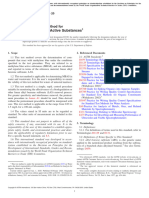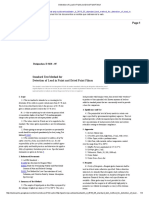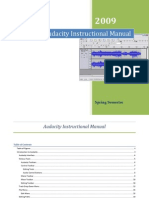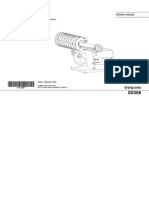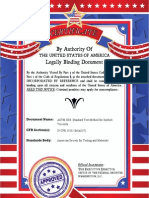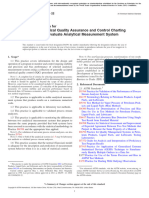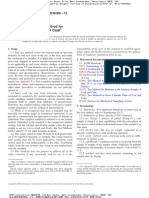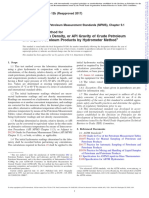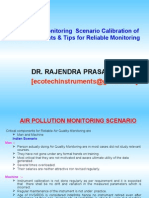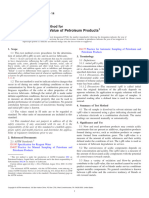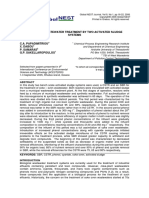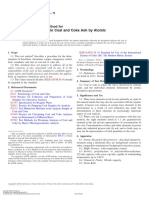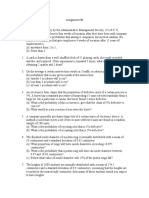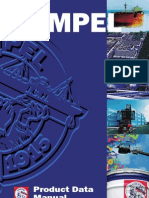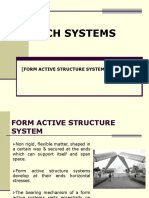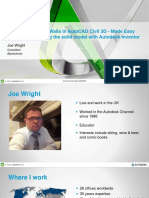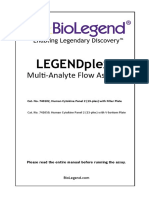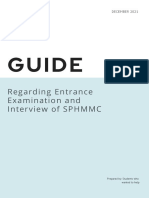Astm D409 D409M - 2011 - 208417808126
Astm D409 D409M - 2011 - 208417808126
Uploaded by
Simin Coke Co.Copyright:
Available Formats
Astm D409 D409M - 2011 - 208417808126
Astm D409 D409M - 2011 - 208417808126
Uploaded by
Simin Coke Co.Original Title
Copyright
Available Formats
Share this document
Did you find this document useful?
Is this content inappropriate?
Copyright:
Available Formats
Astm D409 D409M - 2011 - 208417808126
Astm D409 D409M - 2011 - 208417808126
Uploaded by
Simin Coke Co.Copyright:
Available Formats
Designation: D409/D409M – 11
Standard Test Method for
Grindability of Coal by the Hardgrove-Machine Method1
This standard is issued under the fixed designation D409/D409M; the number immediately following the designation indicates the year
of original adoption or, in the case of revision, the year of last revision. A number in parentheses indicates the year of last reapproval.
A superscript epsilon (´) indicates an editorial change since the last revision or reapproval.
This standard has been approved for use by agencies of the Department of Defense.
INTRODUCTION
This test method is structured into the following parts:
The body of the test method discusses the scope, referenced documents, significance and use,
apparatus, gross samples, preparation of test samples, procedure, calculation and report, precision and
bias, and keywords.
Annex A1 contains the method to obtain and prepare coal feedstock for potential use as HGI RMs
(reference materials).
Annex A2 contains the method to divide and containerize the candidate HGI RMs (candidate HGI
RMs) from the feedstock prepared in Annex A1.
Annex A3 contains the method for homogeneity testing of the candidate HGI RMs containerized in
Annex A2.
Annex A4 contains the method for determining the Hardgrove grindability index (HGI) to be
assigned to each lot of the candidate HGI RMs.
Annex A5 contains the method used to calibrate a Hardgrove grindability machine using the primary
or secondary HGI RMs.
Annex A6 contains the method for determining the moisture content of the 1.18 3 0.60 mm (No.
16 3 30) test sample.
1. Scope used to produce an index relative to the ease of grinding
1.1 This test method2 covers the determination of the [Hardgrove Grindability Index (HGI)].
relative grindability or ease of pulverization of coals in 1.1.1 Some coals, such as some high-volatile bituminous,
comparison with coals chosen as standards. A prepared and subbituminous, and lignite coals, can undergo physical change
sized sample receives a definite amount of grinding energy in as the natural or seam moisture is released during handling and
a miniature pulverizer, and the size consist of the pulverized preparation. This change is often sufficient to alter the grind-
product is determined by sieving. The resultant size consist is ability characteristics that will be reported when tested in the
laboratory and could produce different indices dependent on
the conditions of drying and the moisture level of the 1.18 3
1
This test method is under the jurisdiction of ASTM Committee D05 on Coal
0.60 mm (No. 16 3 30) (see Test Method D4749) materials
and Coke and is the direct responsibility of D05.07 on Physical Characteristics of used for the test. Therefore, the repeatability and reproducibil-
Coal. ity cited in this test method may not apply for these high-
Current edition approved April 1, 2011. Published April 2011. Originally volatile bituminous, subbituminous, and lignite coals.
approved in 1951. Last previous edition approved in 2009 as D409 – 09A ´1. DOI:
10.1520/D0409_D0409M-11. 1.2 The values stated in either SI units or inch-pound units
2
For information concerning the experimental work on which this test method is are to be regarded separately as standard. The values stated in
based, see paper by Hardgrove, R. M., “Grindability of Coal,” Transactions, each system may not be exact equivalents; therefore, each
American Society of Mechanical Engineers, Vol 54, F.S.P., p. 37, 1932.
D05.07 on Physical Characteristics on Coal is conducting ongoing investigations
system shall be used independently of the other. Combining
in regard to quality control during preparation, distribution, and use of standard values from the two systems may result in non-conformance
reference materials and during preparation and testing of actual samples. with the standard.
Copyright © ASTM International, 100 Barr Harbor Drive, PO Box C700, West Conshohocken, PA 19428-2959, United States.
--`,,```,,,,````-`-`,,`,,`,`,,`---
Copyright ASTM International
Provided by IHS under license with ASTM
1
No reproduction or networking permitted without license from IHS Not for Resale
D409/D409M – 11
1.3 This standard does not purport to address all of the sufficient capacity to weigh a sample with a mass of greater
safety concerns, if any, associated with its use. It is the than or equal to 1000g along with the drying pan.
responsibility of the user of this standard to establish appro- 4.4 Balance [for weighing the 50-g test sample and the sieve
priate safety and health practices and determine the applica- fractions formed during milling]—With a sensitivity of at least
bility of regulatory limitations prior to use. 10 mg and a minimum capacity of 800 g.
2. Referenced Documents NOTE 1—A single balance meeting the specifications of 4.3 and 4.4 is
permitted.
2.1 ASTM Standards:3
D2013 Practice for Preparing Coal Samples for Analysis 4.5 Calibration Weights—These calibration weights shall
be used periodically to monitor the response of each balance
--`,,```,,,,````-`-`,,`,,`,`,,`---
D2234/D2234M Practice for Collection of a Gross Sample
of Coal over the working range.
D3302 Test Method for Total Moisture in Coal 4.6 Sample Divider— An enclosed riffle divider with feed
D4749 Test Method for Performing the Sieve Analysis of chute as described in Practice D2013 or a rotary sample
Coal and Designating Coal Size divider, which has been proven to be free of significant bias,
D6708 Practice for Statistical Assessment and Improvement may be used.
of Expected Agreement Between Two Test Methods that 4.7 Standard Sieves—A working set of circular, standard
Purport to Measure the Same Property of a Material testing sieves, which are 203 mm [8 in.] in diameter and
D6883 Practice for Manual Sampling of Stationary Coal conform to Specification E11, are required in the following
from Railroad Cars, Barges, Trucks, or Stockpiles sizes, together with cover and catch pan (receiver):
D7430 Practice for Mechanical Sampling of Coal
E11 Specification for Woven Wire Test Sieve Cloth and Test TABLE 1 Standard Sieves for HGI Testing
Sieves E11 Specification U.S.A. Standard Sieve Series Designation
16.0 mm 5⁄8 in.
3. Significance and Use 4.75 mm No. 4
2.36 mm No. 8
3.1 This test method develops a measurement of grinding or 1.18 mm No. 16
pulverizing characteristics that can be used to evaluate the 600 µm No. 30
yield, or energy input, or both, required in a grinding or 75 µm No. 200
pulverizing process, which can impact a wide variety of 4.7.1 These working sieves must be periodically inspected
processes, including combustion, coke-making, liquefaction, for wear or damage. Any excessively worn or damaged sieves
and gasification. (for example, sieves with holes, tears, cracks; etc.) must be
replaced immediately, and the HGI calibration procedure must
4. Apparatus be repeated after the damaged sieves are replaced (see Annex
4.1 Air-Drying Oven [for air-drying the 1000 g, 4.75 mm A5). Since the HGI depends upon the sieve analysis and since
(No. 4) sample]—A device for passing slightly heated air over the 75-µm (No. 200) sieve is fragile, it is recommended that at
the sample. The oven shall be capable of maintaining a least one set of working sieves be obtained, identified, and used
temperature of 10 to 15 °C [18 to 27 °F] above room tempera- exclusively for HGI determinations and that only this exclusive
ture with a maximum oven temperature of 40 °C [104 °F] set of sieves be used for determining HGI.
unless ambient temperature is above 40 °C, in which case 4.7.1.1 Excessive wear may be indicated by poor repeatabil-
ambient temperature shall be used. In the case of easily ity or by failure of quality control checks (A5.4.1.1) to agree
oxidized coals, the temperature shall not be over 10 °C [18 °F] reasonably with the initial calibration data.
above room temperature unless ambient temperature is above 4.7.2 Normal wear on sieves is compensated by the use of
37 °C [100 °F] in which case ambient temperature shall be primary HGI standard reference samples (HGI RMs) and
used. Air changes shall be at the rate of 1 to 4 air volumes of proper calibration of equipment; excessive wear (such as holes
oven capacity per minute. or tears in the sieve cloth, and so forth) is not compensated by
4.2 Drying Pans [for air-drying the 1000 g, 4.75 mm (No. 4) HGI RMs. Because excessive wear is unacceptable, inspect
sample]—Drying pans of sufficient size so that the sample may sieves carefully before each test to ensure the absence of
be spread to a depth of not more than 25 mm [1.0 in.] with excessive wear. For the 75- and 600-µm (No. 200 and 30)
sides not more than 38 mm [1.5 in.] high. The pans shall be sieves, use only a soft-bristled brush (such as short-bristled
nonreactive with coal and unaffected by the method of air camel hair) for brushing and cleaning.
drying selected. 4.7.2.1 It is good practice to keep a separate primary 75-µm
4.3 Balance [for weighing the 1000-g sample before and (No. 200) check sieve to be used only to check the 75-µm (No.
after air-drying and the sieve fractions formed during stage- 200) working sieves described in 4.7.1 whenever the working
crushing]—With a sensitivity of at least 0.5 g in 1000 g and sieve becomes suspect. This check is done by running a
comparative HGI test between the two 75-µm (No. 200) sieves.
Use of the working sieve for HGIs should be discontinued if
3
For referenced ASTM standards, visit the ASTM website, www.astm.org, or HGI difference between the sieves is greater than 1 HGI unit.
contact ASTM Customer Service at service@astm.org. For Annual Book of ASTM
Standards volume information, refer to the standard’s Document Summary page on 4.8 Plate Mill Crusher—A laboratory plate mill capable of
the ASTM website. reducing 4.75-mm (No. 4) sieve size coal particles with the
Copyright ASTM International
Provided by IHS under license with ASTM
2
No reproduction or networking permitted without license from IHS Not for Resale
D409/D409M – 11
production of a minimum of minus 0.60-mm (minus No. 30) 4.10.1 It is good laboratory practice to have the dimensions
sieve size material. The crusher plates shall be serrated and and the tolerances components that are subject to wear verified
about 100 mm [4 in.] in diameter. The distance between the on a periodic basis.
plates shall be adjustable, and the relative speed of rotation of 4.10.2 The position of the counter trip mechanism before
the plates shall not exceed 200 r/min. and after the test must be used to determine the number of
4.8.1 Evidence from HGI standard reference sample user- revolutions completed. With some machines, it may be neces-
response forms (A5.4.4) indicates that the median value of sary to position strategically the counter trip mechanism at the
% Yield (8.3) of the 4.75-mm (No. 4) material as 1.18 3 0.60 beginning of the test to accomplish the desired number of
mm (No. 16 3 30) material, regardless of the HGI level, is revolutions (that is, during a set-up period, watch where the trip
about 55 %. Use this median value to gage the effectiveness/ mechanism is initially, count the number of revolutions from
efficiency of the stage-crusher and of the stage-crushing the point of origin, determine where the trip mechanism is at
process, while noting that, in some situations, the % Yield has the end of the test, and determine if the specified 60 6 0.25
been as low as 45%. revolutions are obtained. If not, adjust the position of the trip
4.8.2 The most frequently used plate mill can be equipped mechanism at the beginning of the test until the specified
with “fine” or “coarse” plates. One independent study4 has number of revolutions are obtained). Periodically, verify that
found evidence of differences in percent recovery resulting the machine is operated to obtain the specified number of
from use of different types of plate. In order to obtain the revolutions per test.
maximum % Yield, only the coarse plate should be used in
preparation of both HGI calibration standards and unknown 5. Gross Samples
samples. 5.1 Collect a gross sample of coal, representative of the
4.9 Mechanical Sieving Machine—The mechanical sieving material from which it is taken. The sample may be collected,
machine shall accept an assembly of vertically nested circular in accordance with Practice D2234/D2234M, D6883, or D7430
sieves of 203 mm [8 in.] in diameter, together with cover and (or equivalent other international or national standard), and
receiver. The machine shall simulate the motions given testing prepared in accordance with Practice D2013 (or equivalent
--`,,```,,,,````-`-`,,`,,`,`,,`---
sieves during hand sieving by imparting a horizontal oscilla- other international or national standard) except that the sample
tory motion of approximately 28-mm [1.1-in.] amplitude at a topsize shall not be reduced beyond the 4.75-mm (No. 4) sieve
rate of approximately 300 oscillations or cycles per minute and the sample shall have a mass of at least 1000 g.
(cpm). Simultaneously, the top of the oscillating assembly is 5.2 If the topsize of the final sample product produced from
struck at a rate of approximately 150 blows per minute by a mechanical sampling system is smaller than 4.75mm (No. 4),
mass of 1.9 kg [4.2 lb] moving through a vertical distance of the sample does not meet the requirements of this test
approximately 28 mm [1.1 in.] under the influence of gravity. procedure.
4.9.1 Whenever a mechanical sieving machine other than
the reference machine described above is used, the method 6. Preparation of Test Samples
may be shown to be equivalent by one of two methods (1) side 6.1 Prepare a 1.18 3 0.60 mm (No. 16 3 30) test sample
x side equivalency testing of the alternative machine vs. the for establishing the HGI of HGI RMs (Annex A4 ), for
reference machine (with both calibration and test samples that calibration (Annex A5), or for routine determination of HGI.
cover the working range), using the equivalency testing statis- 6.2 When necessary, divide the quantity of 4.75-mm (No. 4)
tical technique of D6708 or (2) acceptable performance in an sieve size coal to not less than 1000-g lots using an enclosed
appropriate proficiency test program that covers the working riffle or rotary sample divider, and air dry each sample in
range. conformance with Test Method D3302. To calculate the
4.10 Grindability Machine—The Hardgrove Grindability % Yield (8.3), record the mass of the air-dried sample (m1).
Machine such as is shown in Fig. 1 is required for this test. 6.3 Sieve the entire amount (1000 g) of air-dried 4.75-mm
Essential tolerances and specifications are shown in Fig. 2. The (No. 4) sieve size sample in lots of no greater than 250 g for 2
grindability machine includes a stationary grinding bowl of min 6 10 s in the mechanical sieving machine. Use a set of
polished cast iron, with a circular horizontal track that holds nested sieves consisting of a 1.18-mm (No. 16) sieve on top of
eight polished steel balls, each 25.40 6 0.13 mm [1.000 6 a 0.60-mm (No. 30) sieve. Weigh and record the mass of each
0.005 in.] in diameter. The balls are driven by an upper sieve size.
grinding ring which is rotated at 20 6 1 r/min by means of the 6.3.1 Include a 4.75-mm (No. 4) and a 2.36-mm (No. 8)
upper spindle and which, in turn, is driven by an electric motor sieve in this nest of sieves to ease separation, determine and
through reduction gears or, in newer models, belts. Weights are record the “natural” particle size distribution, and to verify that
added to the driving spindle so that the total vertical force on the topsize of the sample is appropriate for this test. Sieving
the balls as a result of the weights, shaft, top grinding ring, and more than 250 g at a time on the 200-mm [8-in.] diameter sieve
gear is equal to 29.0 6 0.2 kg [64 6 0.5 lb]. The machine is may not allow each particle to “see” the sieve surface and have
equipped with a counter and automatic device, which can be an opportunity to pass or to be retained by the sieve.
properly adjusted for stopping the machine after 60 6 0.25 6.4 Combine and stage crush all of the sieve fractions
revolutions. greater than the 1.18-mm (No. 16) sieve with the crusher
adjusted so that only the largest particles are crushed. Sieve the
crushed material in portions of no greater than 250 g for 2 min
4
D05.07 Minutes, J. Gardner, Georgia Power and G. Linton, October 1990. 6 10 s in the mechanical sieving machine. Return the oversize
Copyright ASTM International
Provided by IHS under license with ASTM
3
No reproduction or networking permitted without license from IHS Not for Resale
D409/D409M – 11
FIG. 1 Hardgrove Grindability Machine
Item Mass, kg Mass, lb
Lead 25.9 57.0
Shaft and Gear 20.0 4.5
Top Ring 1.1 2.5
Total 29.0 6 0.2 64.0 6 0.5
to the crusher, after setting the crusher so that only the largest 6.6.1 Determining the mass of each sieve fraction after each
particles are crushed. Continue the stage crushing and sieving stage-crushing step will allow the rate of reduction to be
procedure until all the material passes the 1.18-mm sieve. calculated and evaluated as a contributor to achieving adequate
Retain the 1.18 3 0.60 mm (No. 16 3 30) material. After all % Yield.
stage-crushing is completed, to calculate the % Yield (8.3),
record the mass of the 1.18 3 0.60 mm (No. 16 3 30) fraction 7. Procedure
(m2).
6.5 Mix well all the 1.18 3 0.60 mm (No. 16 3 30) material 7.1 Clean the grindability machine thoroughly, place the
machine on a level surface, and space the balls as evenly as
--`,,```,,,,````-`-`,,`,,`,`,,`---
accumulated from the stage crushing and sieving process and
divide the quantity using an enclosed riffle or rotary sample possible around the grinding bowl. Set the automatic stopping
divider to obtain approximately 120 6 10 g. device so that the motion of the grindability machine will stop
6.6 As the final step in preparation of the test sample, dedust after 60 6 0.25 revolutions of the upper grinding ring.
the 120 6 10-g sample from 6.5 by sieving on a 0.60 mm (No. 7.1.1 If the grindability machine makes a different number
30) sieve for 5 min 6 10 s using the mechanical sieving of revolutions other than the specified 60 6 0.25 revolutions,
machine. the machine must be adjusted to within the tolerance specified.
Copyright ASTM International
Provided by IHS under license with ASTM
4
No reproduction or networking permitted without license from IHS Not for Resale
D409/D409M – 11
75-µm (No. 200) sieve into the receiving pan using a soft-
bristled brush to avoid damaging the sieve. Repeat the shaking
of the ball-milled material and the cleaning of the underside of
the 75-µm (No. 200) sieve for two more periods each of 5-min
6 10-s duration.
7.4.1 Before emptying the contents of the lower grinding
bowl onto the 16-mm [5⁄8-in.] sieve, the tops of the grinding
balls may be brushed and then the balls may be removed from
the lower grinding bowl by use of a magnetic extraction tool.
Each grinding ball is brushed off and set aside; then, the
pulverized coal is emptied from the bowl onto the 16-mm
[5⁄8-in.] sieve.
7.5 Weigh separately to the nearest 0.01 g the coal retained
on the 75-µm (No. 200) sieve (m3) and the coal passing the
75-µm (No. 200) sieve (m4).
7.5.1 Alternatively, predetermine the tare masses of the
75-µm (No. 200) sieve (m5) and the catch pan (m6). After the
sieving of 7.4, weigh the 75-µm (No. 200) sieve and its
contents (m7). Subtract the tare mass to obtain the mass of the
+75-µm (+No. 200) material = m3= m7– m5. Weigh the catch
A = 19.05 6 0.13 mm [ 0.750 6 0.0005 in.] radius pan and its contents (m8). Subtract the tare mass to obtain the
B = 25.40 6 0.13 mm [1.000 6 0.0005 in.] diameter mass of the –75-µm (–No. 200) material = m4= m8– m6.
C = 12.70 mm [0.50 in.]
7.6 If the sum of the +75-µm (+No. 200) (m3) and the
D = 22.23 mm [0.875 in.]
E = 19.05 mm [0.750 in.] -75-µm (-No. 200) (m4) sieve fraction masses differs by more
F = 1.42 mm [0.078 in.] than 0.50 g from the initial mass of 50 6 0.01 g (m9, see 7.2),
G = 60.33 mm [2.375 in.] reject the test and repeat. Use the calculated mass of the coal
H = 98.43 mm [3.875 in.] passing the 75-µm (No. 200) sieve (m10), determined by
I = 76.20 mm [3.000 in.] subtracting the mass retained on the 75-µm (No. 200) sieve
f = smooth machine surface (m3) from the test specimen mass (m9), in determining the
ff = fine machined surface and polished sum-of-least-squares fit (A5.4.3), in preparation of the calibra-
tion chart (A5.4.3.2) or in calculation of the grindability index
FIG. 2 Grinding Elements of Hardgrove Machine of the sample (8.1) m10= m9– m3.
8. Calculation and Report
(This is normally done by strategically placing the counter
tripper arm at the start of the test. See 4.10.2.) 8.1 Calculate the grindability index corresponding to the
7.2 Weigh 50 6 0.01 g of the 1.18 3 0.60 mm (No. 16 3 calculated mass of test specimen passing the 75-µm (No. 200)
30) sieve size dedusted material from 6.6 and distribute it sieve (7.5) directly from the equation of the line prepared in
--`,,```,,,,````-`-`,,`,,`,`,,`---
evenly in the grinding bowl, brushing any material that falls on A5.4.3 and report to the nearest whole number.
the elevated section of the lower grinding element into the 8.2 For ease of comparison between or among laboratories,
lower grinding element, which contains the balls. Fasten the calculate and report the percent residual moisture in the 1.18 3
bowl in position and make sure the load is fully applied to the 0.60 mm (No. 16 3 30) sample (Annex A6).
driving spindle. 8.3 Calculate the % Yield of 1.18 3 0.60 mm (No. 16 3 30)
7.3 Operate the machine for the specified 60.00 6 0.25 material generated from the initial 1000 g of 4.75-mm (No. 4)
revolutions. top-size sample and compare the actual value to a typical
7.4 Remove the bowl from the machine, lift out the upper median value (4.8.1) to gage the effectiveness/efficiency of the
grinding ring, and carefully brush adhering coal dust from the stage-crusher and of the stage-crushing process.
bowl and grinding ring onto a 16-mm [5⁄8-in.] sieve nested on m2
a 75-µm (No. 200) sieve and a closely fitting receiving pan. Y 5 m 3 100 (1)
1
Carefully empty the contents of the bowl onto the 16-mm
[5⁄8-in.] sieve. Brush off material adhering to the balls and where:
remove the balls from the 16-mm [5⁄8-in.] sieve. Brush material Y = % Yield,
adhering to the 16-mm [5⁄8-in.] sieve, including the underside m1 = mass of air dried sample (6.2), and
of the sieve, onto the 75-µm (No. 200) sieve. Replace the m2 = mass of 1.18 3 0.60 mm (No. 16 3 30) material
16-mm [5⁄8-in.] sieve with a close-fitting cover and shake the (6.4).
nested 75-µm (No. 200) sieve; cover and pan for 10 min 6 10 8.4 If other than primary HGI RMs are used for calibration
s in a mechanical sieving machine. After the 10-min 6 10-s of the test apparatus and method, report the source of the
period, carefully brush coal dust from the underside of the calibration standards used.
Copyright ASTM International
Provided by IHS under license with ASTM
5
No reproduction or networking permitted without license from IHS Not for Resale
D409/D409M – 11
8.5 An example of a typical HGI preparation log sheet that TABLE 2 Repeatability and Reproducibility for HGI of Coal
has found application for record keeping during preparation of Repeatability Limit Reproducibility Limit
samples to be used for HGI determination is shown in Fig. 3. r R
2 3
9. Precision and Bias
9.1 Precision:
9.1.1 The precision of this test method for the determination 9.1.2 For the HGI method, the Repeatability Limit (r) in
of Hardgrove Grindability Index of Coal, whenever primary Table 2 is the value which the absolute difference between two
HGI reference materials are used for calibration, is shown in test results of separate and consecutive test determinations,
Table 2. carried out on dedusted 1.18 3 0.60 mm (No. 16 3 30)
--`,,```,,,,````-`-`,,`,,`,`,,`---
FIG. 3 HGI Log Sheet is for Example Only and is Non-Mandatory
Copyright ASTM International
Provided by IHS under license with ASTM
6
No reproduction or networking permitted without license from IHS Not for Resale
D409/D409M – 11
samples in the same laboratory by the same operator using the ISO national member body (NMB) and/or their national
same apparatus on samples taken at random from a single organization responsible for obtaining and preparing national
quantity of homogeneous 4.75 mm (No. 4) material, may be (secondary) HGI RMs. The precision limits for this test
expected to occur with a probability of approximately 95 %. method, whenever these national (secondary) RMs are used,
9.1.3 For the HGI method, the Reproducibility Limit (R) in will be as large or larger than the precision limits stated in
Table 2 is the value which the absolute difference between two Table 2.
test results, carried out in different laboratories on riffled splits 9.2 Bias—Since this test method (using a calibration proce-
of the 4.75 mm (No. 4) analysis sample, may be expected to dure) is an empirical standard, the degree of absolute bias
occur with a probability of approximately 95 %. cannot be determined.
9.1.3.1 The precision of this test method for the determina-
tion of Hardgrove Grindability Index of Coal, whenever 10. Keywords
national (secondary) HGI reference materials are used for 10.1 grindability; Hardgrove Grindability Index; HGI;
calibration, must be determined and reported by each pertinent pulverization
ANNEXES
(Mandatory Information)
A1. METHOD TO OBTAIN AND PREPARE HGI REFERENCE MATERIAL FEEDSTOCK
(HGI RM Feedstock)
A1.1 Scope feedstock shall have an HGI of approximately 100 (typically
A1.1.1 This method describes the procedures used to obtain between 90 and 110).
and prepare Hardgrove Grindability Index (HGI) reference A1.3.2 Each HGI RM feedstock shall have a minimum
material feedstock (HGI RM feedstock). mass of 80 kg [175 lb]. Where 80 kg [175 lb] is not adequate
A1.1.1.1 Recognition to obtain and prepare HGI RM feed- to produce the desired number of candidate RMs, an adequate
stock for use as candidate primary HGI RMs is given by ASTM mass to produce the desired number of candidate HGI RMs
Committee D05 on Coal and Coke. shall be obtained. Each candidate RM sample shall have a
minimum mass of 1000 g.
A1.1.1.2 Authority to obtain and prepare HGI RM feed-
stock for use as candidate secondary HGI RMs is given by the A1.3.3 Any feedstock will be acceptable as long as the final
pertinent ISO national member body (NMB), which maintains production lot meets the homogeneity requirements found in
oversight responsibility for these activities. Annex A3.
A1.3.4 To minimize the potential rejection of a production
lot of HGI RMs after the lot has been processed, each
A1.2 Apparatus
feedstock coal should have the following characteristics: (1) be
A1.2.1 Sieves; 4.75 mm (No. 4) and 2.36 mm (No. 8)— from a single seam, containing no blended materials, (2) be
Square mesh sieves meeting the requirements of Test Method double-sieved to pass a 63-mm [2.5-in.] square-hole sieve
D4749, used to verify that the candidate HGI RMs are while being retained on a 3.35-mm [1⁄8-in.] square-holed sieve,
4.75-mm (No. 4) topsize. and (3) be mechanically cleaned, having been through a
A1.2.2 Sieve Shaker—Meeting the requirements of Test preparation or wash plant to remove non-coal material.
Method D4749, used to verify that the candidate HGI RMs are A1.3.5 Each feedstock coal shall be visually inspected upon
4.75-mm (No. 4) topsize. its receipt to assure the absence of foreign material. If any
A1.2.2.1 No specifications are given for the sieve shaker foreign material (wood, rock, slate, steel, and so forth) is
used in the processing of the feedstock; as long as the final present, the entire shipment shall be rejected.
product meets the specification of being 4.75-mm (No. 4) A1.3.6 Each feedstock coal shall be visually inspected upon
topsize, there is no need to specify production equipment. its receipt to assure the absence of more than 5 % of undersized
A1.2.3 Crusher—Commensurate with the requirement to −3.35-mm [-1⁄8 in.] or of oversized +63- mm [+2.5 in.]
maximize the 1.18 3 0.60-mm (No. 16 3 30) size fraction particles. If undersized −3.35-mm [-1⁄8 in.] or oversized
while maintaining a 4.75-mm (No. 4) topsize. +63-mm [+2.5 in.] material constitutes greater than 5 % of the
lot, after air-drying, the entire shipment shall be sieved to
A1.3 HGI RM Feedstock Requirements remove the undersize or oversize prior to further processing.
A1.3.1 Four coals shall be collected and used as the
feedstock for the HGI RMs. One feedstock shall have an HGI A1.4 Preparation of Each Candidate HGI RM
of approximately 40 (typically between 35 and 45); a second A1.4.1 Each feedstock is prepared according to the instruc-
feedstock shall have an HGI of approximately 60 (typically tions in this section.
between 55 and 65); a third feedstock shall have an HGI of A1.4.2 Spread the feedstock coal (onto a smooth, flat,
approximately 80 (typically between 75 and 85); and a fourth non-contaminating surface) to a thickness of no more than
--`,,```,,,,````-`-`,,`,,`,`,,`---
Copyright ASTM International
Provided by IHS under license with ASTM
7
No reproduction or networking permitted without license from IHS Not for Resale
D409/D409M – 11
three times the particle topsize. A floor fan and periodic stirring conducting a size analysis [at 4.75 and 2.36 mm (No. 4 and 8)]
can accelerate drying. Air dry the feedstock at room tempera- according to the requirements of Test Method D4749. No more
ture for at least 12 h. than 5 % of the sample may be retained on a 4.75-mm (No. 4)
A1.4.2.1 If, after air drying, a feedstock contains greater sieve and no less than 5 % of the sample may be retained on a
than 5 % undersize (−3.35-mm) [-1⁄8 in.] or greater than 5 % 2.36-mm (No. 8) sieve (cumulative retained basis).
oversize +63-mm [+2.5 in.], sieve the entire feedstock coal to A1.4.4 Dedust each feedstock by removing and discarding
remove the undersize or oversize. the −0.30-mm (−No. 50) material.
A1.4.3 Reduce the air-dried feedstock to 4.75-mm (No. 4)
top size. Use a crusher and a technique that will maximize the A1.4.5 If the feedstock is to be transported or held for
1.18 3 0.60 mm (No. 16 3 30) size fraction while maintaining subsequent processing, package the material in a rigid, non-
a 4.75-mm (No. 4) topsize. contaminating container. If necessary, line the container with
A1.4.3.1 Verify that each reduced feedstock is a 4.75-mm double plastic liners to preserve the feedstock integrity and
(No. 4) topsize by obtaining a sample from each feedstock and avoid excessive handling.
A2. METHOD TO DIVIDE AND CONTAINERIZE CANDIDATE HGI REFERENCE MATERIALS
(Candidate HGI RMs)
A2.1 Scope A2.3 Blending and Division of Each Feedstock
A2.1.1 This method describes the procedures used to divide A2.3.1 Each feedstock is blended and divided according to
and containerize candidate Hardgrove Grindability Index the instructions in this section (A2.3).
(HGI) reference materials (candidate HGI RMs). A2.3.2 Thoroughly mix the feedstock for at least 30 min in
A2.1.2 Recognition to divide and containerize candidate a blender with a capacity to contain the entire feedstock at
primary HGI RMs for use in determining the HGI of coal (or once.
for calibrating national HGI machines) is given by ASTM A2.3.3 Divide the blended feedstock coal into candidate
Committee D05 on Coal and Coke. HGI RMs.
A2.1.3 Authority to divide and containerize candidate sec- A2.3.3.1 Feed the feedstock at a uniform rate from the
ondary HGI RMs for use in determining the HGI of coal is stationary hopper/feeder into containers located on the perim-
given by the pertinent ISO national member body (NMB), eter of a rotary sample divider (RSD), which is rotating at a
which maintains oversight responsibility for these activities. steady rate. Assign container number “1” to the container that
A2.1.4 Other methods for the division of the candidate HGI is located at a defined position on the RSD and number all
RMs (for example, riffle division or incremental division) may remaining containers counterclockwise in consecutive order
be used as long as the resulting candidate HGI RMs meet the (that is, 1, 2, 3, …, x-1, x). Locate container “1” at such a
homogeneity requirements of Annex A3. position that, once the flow starts from the feeder into the
containers, container “1” is at or near the location that receives
the first increment (that is, start the RSD and, once the RSD is
A2.2 Apparatus
rotating at a steady rate, then start the feeder in such a manner
A2.2.1 Blender/Mixer—A rotating device is typically used that container “1” receives the first increment). Adjust the feed
to blend each feedstock before the feedstock is divided into rate such that each container receives a maximum number of
candidate HGI RMs; typically, the blender is a double-cone or increments, but, in no case, shall less than 34 increments be
v-type blender or designed like a cement mixer. [Multiple collected per container.
mixing of the material through a riffle or rotary sample divider A2.3.3.2 A stopwatch or timer should be used during the
is acceptable, as long as the material passes the homogeneity production of each feedstock lot to determine the time required
test (Annex A3).] to empty the hopper/feeder, which time, in conjunction with
A2.2.2 Hopper/Feeder—A device that holds the blended the known constant rpm of the RSD, can be used to calculate
feedstock and allows the feedstock to be feed at a uniform rate the number (and average mass of) increments going into each
into the containers, which are along the perimeter of the rotary container.
sample divider. [A riffle or other type of mechanical divider A2.3.3.3 The number of containers shall be at least 24, but
that does not require a hopper / feeder may be used, as long as may be more, depending upon the configuration of the pro-
the material passes the homogeneity test (Annex A3)] cessing equipment.
A2.2.3 Rotary Sample Divider—A rotating wheel upon A2.3.3.4 After all of the material has been fed into the
which is fixed a level platform, which rotates at a constant containers, seal and label the containers according to the lot
speed and around which perimeter is located a series of and the container number.
uniformly spaced devices, which hold containers into which A2.3.3.5 Ideally, the containers will be labeled before being
the candidate HGI RMs are evenly distributed. [A riffle or other placed in order onto the RSD; alternatively, if assurance is such
type of mechanical divider may be used, as long as the material that the order of the containers remains secure after division,
passes the homogeneity test (Annex A3)] labels may be attached after division.
--`,,```,,,,````-`-`,,`,,`,`,,`---
Copyright ASTM International
Provided by IHS under license with ASTM
8
No reproduction or networking permitted without license from IHS Not for Resale
D409/D409M – 11
A2.3.3.6 Weigh and record the mass of each sealed con- A2.3.3.10 As an example of how these masses may be used,
tainer and the container number. criteria such as the following is established by each authority
A2.3.3.7 From the masses of the packets determined in manufacturing candidate HGI RMs: The average mass per
A2.3.3.6, the average mass per packet is calculated. packet is within 6 10 g of the target mass (that is, within the
A2.3.3.8 The tare mass of a container may be determined range of 1100 to 1120 g whenever the target mass is 1110 g per
individually or a representative number of the containers may packet). The relative standard deviation of all of the packet
be counted and weighed all at once and the average mass per masses is less than 2.50 %.
container used to calculate the mass of HGI RM per packet.
A2.3.3.9 The ordered masses from A2.3.3.7 will be used to
monitor the consistency of the process and to determine if the
mass of material in each container is at least 1000 g.
A3. METHOD FOR HOMOGENEITY TESTING OF CANDIDATE HGI REFERENCE MATERIALS
(Candidate HGI RMs)
A3.1 Scope A3.3.1.4 Balance—For weighing the sieve fractions formed
A3.1.1 This method describes the procedures used to test during stage-crushing.
the homogeneity of the candidate international Hardgrove A3.3.1.5 Grindability Machine—To test the samples for
Grindability Index (HGI) standard reference coal samples HGI.
(candidate HGI RMs). A3.3.1.6 Balance—For weighing the 50-g test sample and
A3.1.2 Recognition to test the homogeneity of the candidate the sieve fractions formed during milling.
primary HGI RMs that will subsequently be used in determin- A3.3.1.7 Calibration Weights.
ing the HGI of coal (or for calibrating national HGI machines) A3.4 Determination of the Homogeneity of Each of the
is given by ASTM Committee D05 on Coal and Coke. Candidate HGI RM Lots
A3.1.3 Authority to test the homogeneity of the candidate
A3.4.1 A lot of a particular candidate HGI RM is the total
secondary HGI RMs that will be subsequently used in deter-
number of HGI RM containers produced from one process
mining the HGI of coal is given by the the pertinent ISO
batch of a feedstock through the production process.
national member body (NMB), which maintains oversight
A3.4.2 Randomly select at least 10 % of the containers from
responsibility for these activities.
each lot.
A3.2 Other Documents A3.4.2.1 In the special case of whenever the number of
Pure Applied Chemistry, Vol. 78, No. 1, pp. 145–196, 2006; containers in the lot is 24, the homogeneity testing may be
The International Harmonized Protocol for the Proficiency conducted at the same time as and as an intimate part of the
Testing of Analytical Chemistry Laboratories; Prepared for process defined in Annex A4.
publication by Michael Thompson, Stephen L. R. Ellison, and A3.4.2.2 In the special case of whenever a lot contains 24
Roger Wood.; Appendix 1, Recommended Procedure for Test- two-kg containers, only 2 containers need to be randomly
ing a Material for Sufficient Homogeneity. selected for homogeneity testing, but the material in each of the
two containers is divided into two subsamples, producing four
A3.3 Apparatus 4.75 mm (No. 4) topsize samples.
A3.3.1 All of the apparatus and equipment shall be as A3.4.3 Prepare the material in each selected container to
prescribed in Section 4 and shall include the following: 1.18 3 0.60 mm (No. 16 3 30).
A3.3.1.1 Standard Sieves—Set of circular, standard testing A3.4.4 Test each prepared 1.18 3 0.60 mm (No. 16 3 30)
sieves to sieve the stage-crushed sample and the milled sample. test sample in duplicate.
A3.3.1.2 Crusher—To reduce the 4.75 mm (No. 4) sample A3.4.5 Conduct homogeneity testing as outlined in Pure
to 1.18 3 0.60 mm (No. 16 3 30) test sample. Applied Chemistry, Vol. 78, No. 1, pp. 145–196, 2006,
A3.3.1.3 Mechanical Sieving Machine—To sieve the stage- Appendix 1. The lot is acceptable for determination and
crushed sample and the milled sample. assignation of HGI values, if this homogeneity test is passed.
--`,,```,,,,````-`-`,,`,,`,`,,`---
Copyright ASTM International
Provided by IHS under license with ASTM
9
No reproduction or networking permitted without license from IHS Not for Resale
D409/D409M – 11
A4. METHOD FOR DETERMINING THE HARDGROVE GRINDABILITY INDEX TO BE ASSIGNED TO EACH LOT OF THE
CANDIDATE HGI REFERENCE MATERIALS
(HGI RMs)
A4.1 Scope A4.3.2 Prepare a test sample from each of the four sub-
A4.1.1 This method describes the procedures used to test samples in accordance with Section 6.
the candidate Hardgrove Grindability Index (HGI) reference A4.3.3 Process each of the four subsamples in the grind-
materials (candidate HGI RMs) to obtain the HGI value to be ability machine in accordance with Section 7 and note the mass
assigned to that lot. of the original sample (50 g) minus the mass of the material
A4.1.2 Recognition to test the candidate primary HGI RMs retained on the 75-µm (No. 200) sieve.
for use in determining the HGI of coal (or for calibrating A4.3.4 (Primary HGI RMs)—To the nearest 0.1 HGI unit,
national HGI machines) is given by ASTM Committee D05 on determine the value of Hardgrove Grindability Index for each
Coal and Coke. subsample from the equation of the line (least squares regres-
sion line) or from the standardization graph derived from the
A4.1.3 Authority to test the candidate secondary HGI RMs
correlation of data between the standardization equipment
for use in determining the HGI of coal is given by the pertinent
reserved exclusively for HGI RM standardization purposes and
ISO national member body (NMB), which maintains oversight
the original equipment previously used by the Babcock &
responsibility for these activities.
Wilcox Co. (the “Hardgrove” sieve) for standard samples.
A4.3.5 (Secondary HGI RMs)—To the nearest 0.1 HGI unit,
A4.2 Apparatus
determine the value of Hardgrove Grindability Index for each
A4.2.1 All apparatus and equipment is essentially as pre- subsample from the equation of the line (least squares regres-
scribed in Section 4 but with the following special precautions sion line) or from the standardization graph derived from the
being taken: correlation of data between the standardization equipment
A4.2.1.1 A mechanical sieving machine (4.9) and a grind- reserved exclusively for HGI RM standardization purposes and
--`,,```,,,,````-`-`,,`,,`,`,,`---
ability machine (4.10) are both to be reserved for use only for the set of four primary HGI RMs obtained from the primary
determining HGI of the candidate HGI RMs. HGI RM producer.5
A4.2.1.2 At least four specially calibrated, stainless steel A4.3.6 Calculate the average and the standard deviation of
75-µm (No. 200) square-mesh sieves shall be set aside for use the four values obtained in A4.3.4 or A4.3.5 and report the HGI
only in determining the HGI of the HGI RMs [that is, in to the nearest whole number and the standard deviation to the
determining the amount of material passing the 75-µm (No. nearest 0.1 unit. Assign this average whole-number HGI value
200) sieve in 7.5]. One of the sieves (the primary “master” to the remaining HGI RMs in that lot.
sieve) is used only to check the secondary sieve, as needed. A4.3.7 (Primary HGI RMs)—Report the average value and
The secondary sieve is used to check the two (or more) the standard deviation (as well as individual analyses, analyst
working sieves at least annually. The two (or more) working identity, container identity, sieve identity, etc.) to the chairman
sieves are to be used only for determining HGI to be assigned of the ASTM D05.07 Producer Liaison Task Group.
to the the candidate HGI RMs. A4.3.8 (Secondary HGI RMs)—Report the average value
and the standard deviation (as well as individual analyses,
A4.3 Determination of Grindability Index of Each Lot of analyst identity, container identity, sieve identity, etc.) to the
HGI Reference Materials chairman of the pertinent NMB oversight committee.
A4.3.1 Randomly select four of the containers remaining
5
after the process defined in Annex A3 has been completed and The sole source of supply of the primary HGI reference materials (HGI RMs)
recognized by the committee at this time are available from The Pennsylvania State
the lot has been deemed to be homogeneous. University. Contact Brad Maben; Address: EMS Energy Institute, Pennsylvania
A4.3.1.1 In the special case of whenever the number of State Univeristy, C-211 CUL, University Park, PA US 16802; Telephone: +1-814-
containers in a lot is 24, randomly select and riffle-divide two 865–3899 (back up Telephone: +1-814-863-8896); Fax: +1-814-863-7432; email:
bam17@psu.edu; web-site: www.energy.psu.edu/HGI/index.html. ASTM Subcom-
containers from each given lot of candidate HGI RMs resulting mittee D05.07 and the ASTM/DOE Liaison Task Group maintains oversight for
from the process defined in Annex A2. Each of the four production of only the HGI RMs. Secondary standard reference samples are
resulting samples is tested for HGI according to the method available from other sources. If you are aware of alternative suppliers, please
provide this information to ASTM International Headquarters. Your comments will
described in the body of this test method. (Two different
receive careful consideration at a meeting of the responsible technical committee,1
technicians shall each test one portion obtained from each of which you may attend.
the two selected samples.)
Copyright ASTM International
Provided by IHS under license with ASTM
10
No reproduction or networking permitted without license from IHS Not for Resale
D409/D409M – 11
A5. CALIBRATION OF HARDGROVE MACHINE
(HGI Machine)
A5.1 Scope A5.4.3 By the method of the sum of least squares, determine
A5.1.1 This method describes the procedure used to cali- the equation of the line that best fits the analytical results
brate Hardgrove machines. obtained from the four HGI RMs. An example HGI calculation
A5.1.2 Such Hardgrove machines can be used by pertinent from HGI RM data, shown in Table A5.1, illustrates this
ISO national member bodies (NMB) to assign values to lots of method.
candidate secondary HGI RMs. (See Annex A4.) A5.4.3.1 Example—Sum of Least Squares Fit—The equa-
A5.1.3 Such Hardgrove machines can be used by coal- tion of the line for the sum of least squares takes the form of:
analysis laboratories, which are then used for determining the Y 5 a 1 bX (A5.1)
HGI of coal.
where:
A5.2 HGI Reference Materials (HGI RMs) for Y = HGI,
Calibration5 a = y axis intercept,
A5.2.1 Four HGI RMs prepared especially for this purpose b = slope of the regression line, and
X = calculated −75-µm (−No. 200) material.
(in accordance with Annex A1-Annex A4) and representing
(1) a and b can be determined by use of the following table
grindability indices of approximately 40, 60, 80, and 100 shall
and equations:
be used for calibration.
Y X X2 XY
A5.2.2 Upon receipt, each of the HGI RMs should be 40 4.35 18.92 174.00
examined for the following: 58 7.14 50.98 414.12
A5.2.2.1 Preparation date (no more than six months old). 83 10.44 108.99 866.52
100 13.38 179.02 1338.00
A5.2.2.2 Oversize (material retained on a 4.75-mm (No.4 (Y = 281 (X = 35.31 ((X2) = 357.91 ((XY) = 2792.64
in.) sieve). {Less than 5 % +4.75 mm (No. 4.) and no particle
on a 6.30-mm [1⁄4-in. square-holed sieve]}. (Y(X2 2 (X(XY
a5 (A5.2)
A5.2.2.3 Foreign, noncoal material (no wood, rock, slate, n(X2 2 ~ (X!2
and so forth).
A5.2.2.4 Excessive fines [more than 30% −0.60-mm (−No. n(XY 2 (X(Y
b5 (A5.3)
30) material]. n(X2 2 ~ (X!2
A5.2.3 Whenever any of these parameters are unacceptable,
contact the agency responsible for production of the HGI RMs where:
(Y = 281,
and report the data on the response form accompanying the
(X = 35.31,
HGI RMs (see A5.4.4). ((X2) = 357.91,
A5.3 Apparatus ((XY) = 2792.64,
((X)2 = 1246.80, and
A5.3.1 All apparatus and equipment is that described in n = 4.
Section 4. (2) By doing these calculations, a = 10.63 and b = 6.75.
A5.4 Calibration Therefore, the equation of the line for this database is
HGI = 10.63 + 6.75 (calculated −75-µm (−No. 200) material).
A5.4.1 Calibrate each grindability machine, together with
A5.4.3.2 Use results from HGI RMs processed in accor-
all ancillary equipment including sieves (4.7) and plate mill
dance with Sections 6 and 7 in determining the equation of the
crusher (4.8), that will be used for this test when new, modified,
line by the sum of least squares method and (optionally) in
repaired, suspected of being defective, or when operated by
preparing the calibration chart (see Fig. A5.1).
new personnel.
A5.4.4 (Primary HGI RMs)—A standard form for reporting
A5.4.1.1 HGI RMs shall not be used for calibration beyond
data obtained during calibration is received with each set of
18 months from their preparation date. It is good practice to
HGI RMs received from the producer of the primary HGI
check the calibration of the HGI apparatus periodically with at
--`,,```,,,,````-`-`,,`,,`,`,,`---
least one of the HGI RMs (quality control check sample) even
if none of the conditions in A5.4.1 apply. This will ensure that TABLE A5.1 Example HGI Data Calculation—Actual Mass of
the system is still in control and it will allow for detection of Materials, g
problems previously unnoticed or not then occurring, and it Calculated,
+75 µm –75 µm
will allow for use of the HGI RMs before their expiration date. HGIA mass, iB
(+No. 200) (–No. 200)
Recovered Lost –75 µm
A5.4.2 For each calibration, process each of the four HGI (–No. 200)
RMs with indices of approximately 40, 60, 80, and 100 as 40 50.00 45.65 4.27 49.92 0.08 4.35
58 50.00 42.86 7.11 49.97 0.03 7.14
described in Sections 6 and 7 and use the results to determine 83 50.00 39.56 10.23 49.79 0.21 10.44
the equation of the line by use of the sum of least squares 100 49.99 36.61 13.25 49.86 0.13 13.38
method (A5.4.3) and, if desired, to prepare a calibration chart A
Value issued with HGI RMs.
(A5.4.3.1). B
Initial mass, g.
Copyright ASTM International
Provided by IHS under license with ASTM
11
No reproduction or networking permitted without license from IHS Not for Resale
D409/D409M – 11
--`,,```,,,,````-`-`,,`,,`,`,,`---
NOTE—Example: Use certified HGI RM and develop a similar calibration chart(s) for each HGI apparatus, or sieve sets, or both.
FIG. A5.1 Example Calibration Chart
RMs.5 This form shall be completed and returned to the tion chart/equation) shall be verified against primary HGI
producer of the primary HGI RMs as noted on the form. A copy reference materials (HGI RMs). Where the calibration has
of this form is sent by the producer of the primary HGI RMs changed, the national Hardgrove machine will be recalibrated
to the ASTM D05 Producer Liaison Task Group for use in against the primary HGI RMs and a new calibration curve/
monitoring the primary HGI RMs. equation of the line determined and used.
A5.5 Verification/Recalibration
A5.5.1 At a period of no longer than 36 months, the
calibration of a national Hardgrove machine (with its calibra-
Copyright ASTM International
Provided by IHS under license with ASTM
12
No reproduction or networking permitted without license from IHS Not for Resale
D409/D409M – 11
A6. METHOD FOR DETERMINING THE MOISTURE CONTENT OF THE 1.18 3 0.60 mm (No. 16 3 30) TEST SAMPLE
(Moisture Content)
A6.1 Scope air in the desiccator is dry to a moisture content of 1.9 mg/L or less. Values
in parentheses ( ) are literature values for the residual amount of moisture
A6.1.1 This method describes the procedures used to deter- in air at equilibrium with these desiccants.
mine the moisture content of the 1.18 3 0.60-mm (No. 16 3 NOTE A6.2—Warning: Sulfuric acid is corrosive and can cause severe
30) test sample. damage to eyes, skin, and clothing. Magnesium perchlorate is a strong
oxidant and can react violently with organic materials.
A6.2 Apparatus
A6.2.1 Drying Oven, Minimum Free Space [for moisture in A6.4 Moisture in the 1.18 3 0.60-mm (No. 16 3 30) Test
the 1.18 3 0.60-mm (No. 16 3 30) sample]—The oven shall Sample
be so constructed as to have a uniform temperature in all parts, A6.4.1 Heat an empty weighing dish under the conditions at
have a minimum of air space, and be capable of temperature which the 10-g sample is to be dried, place the cover on the
regulation between the limits of 104 and 110 °C [220 and weighing dish, cool the cover and dish in the desiccator until
230 °F]. Provision shall be made for renewing the preheated air the dish has cooled to ambient temperature, and weigh the dish
in the oven at a flow-rate of between approximately 2 to 4 and cover to 6 0.1 mg (m11).
times the oven volumes per minute. A6.4.2 Place the cover on the balance and the weighing dish
A6.2.2 Weighing Dish [for moisture in the 1.18 3 0.60-mm on the cover. Tare the balance (so the balance reads 0.0000 g).
(No. 16 3 30) sample] —Shallow, of glass, porcelain, fused With a spatula, collect increments from the unused 1.18 3
silica, or of corrosion-resistant metal, with a well-fitting cover, 0.60-mm (No. 16 3 No. 30) sieve size dedusted material until
of such a size that the coal layer does not exceed 0.20 g/cm2. approximately 10 6 0.1 g of the sample is in the weighing dish.
The dish should be as shallow as possible, consistent with Distribute the 10 g of sample evenly in the weighing dish.
convenient handling. Weigh the dish, cover, and sample (the “assembly”) at once to
A6.2.3 Desiccator, or similar cooling vessel—Adequate for 6 0.1 mg (m12).
allowing cooling of the dried, 10-g, 1.18 3 0.60-mm (No. 16 A6.4.3 Place the assembly near the drying oven, remove the
3 30) sample after the 90-min heating period and before cover, and place the uncovered weighing dish and sample into
weighing back of the dried sample; the desiccator must be the preheated drying oven 107 6 3°C [225 6 5°F]. Close the
adequately designed and maintained as to prevent moisture oven at once and heat for 90 min.
reabsorption/readsorption during cooling. A6.4.4 After 90 minutes, open the drying oven, quickly
A6.2.4 Analytical Balance [for moisture in the 1.18 3 remove and cover the weighing dish and dried sample, place
0.60-mm (No. 16 3 30) sample]—With an approximate the assembly into the desiccator, cool the assembly in the
capacity of at least 100 g, capable of weighing to the nearest desiccator, and weigh the assembly to 6 0.1 mg (m13) as soon
0.1 mg. as the assembly has cooled to ambient temperature.
A6.2.5 Calibration Weights—These calibration weights A6.5 Calculation and Report
shall be used to monitor the response of each balance over the
working range, as required by the laboratory’s quality system. A6.5.1 For ease of comparison between or among labora-
tories, calculate and report the percent moisture in the
A6.3 Reagents 1.1830.60 mm (No. 16 3 30) sample to the nearest 0.01%.
A6.3.1 Dry Air—Air used to purge the drying oven should A6.5.2 Calculate percent moisture in the 1.18 3 0.60-mm
be dried to a moisture content of 1.9 mg/L or less (to a dew (No. 16 3 30) material, M, as follows:
point of 10 °C or less, that is, 30 % relative humidity or less).
Any desiccant or drying method capable of achieving this M5 F m12 G
m12 – ~m13 – m11!
* 100 (A6.1)
degree of dryness is suitable.
A6.3.2 Desiccants—Materials suitable for use in the desic- where:
M = percent moisture in the 1.18 3 0.60-mm (No. 16 3
cator may be chosen from the following:
30) sample, %,
A6.3.2.1 Anhydrous Calcium Sulfate, (0.004 mg/L).
m11 = the mass of the empty weighing dish and cover, g,
A6.3.2.2 Silica Gel. m12 = the mass of the 1.18 3 0.60-mm (No. 16 3 30)
A6.3.2.3 Magnesium Perchlorate, (0.0005 mg/L). sample used, g, and
A6.3.2.4 Sulfuric Acid, Concentrated, (0.003 mg/L). m13 = the mass of the assembly after heating and cooling,
NOTE A6.1—The desiccant must be kept fresh enough to assure that the g.
--`,,```,,,,````-`-`,,`,,`,`,,`---
Copyright ASTM International
Provided by IHS under license with ASTM
13
No reproduction or networking permitted without license from IHS Not for Resale
D409/D409M – 11
ASTM International takes no position respecting the validity of any patent rights asserted in connection with any item mentioned
in this standard. Users of this standard are expressly advised that determination of the validity of any such patent rights, and the risk
of infringement of such rights, are entirely their own responsibility.
This standard is subject to revision at any time by the responsible technical committee and must be reviewed every five years and
if not revised, either reapproved or withdrawn. Your comments are invited either for revision of this standard or for additional standards
and should be addressed to ASTM International Headquarters. Your comments will receive careful consideration at a meeting of the
responsible technical committee, which you may attend. If you feel that your comments have not received a fair hearing you should
make your views known to the ASTM Committee on Standards, at the address shown below.
This standard is copyrighted by ASTM International, 100 Barr Harbor Drive, PO Box C700, West Conshohocken, PA 19428-2959,
United States. Individual reprints (single or multiple copies) of this standard may be obtained by contacting ASTM at the above
address or at 610-832-9585 (phone), 610-832-9555 (fax), or service@astm.org (e-mail); or through the ASTM website
(www.astm.org). Permission rights to photocopy the standard may also be secured from the ASTM website (www.astm.org/
COPYRIGHT/).
--`,,```,,,,````-`-`,,`,,`,`,,`---
Copyright ASTM International
Provided by IHS under license with ASTM
14
No reproduction or networking permitted without license from IHS Not for Resale
You might also like
- ASTM D2330-20 Methylene Blue Active SutancesDocument8 pagesASTM D2330-20 Methylene Blue Active SutancesAna OchoaNo ratings yet
- ASTM E3116 ViscosidadDocument5 pagesASTM E3116 ViscosidadOscar ValenciaNo ratings yet
- FusionDocument11 pagesFusionodbilegNo ratings yet
- D3618-05 Detection of Lead in Paint and Dried Paint Films1Document3 pagesD3618-05 Detection of Lead in Paint and Dried Paint Films1Sara SánNo ratings yet
- PH of Water: Standard Test Methods ForDocument10 pagesPH of Water: Standard Test Methods ForSaravanan NatesanNo ratings yet
- ASTM D3700-14 MuestreoDocument11 pagesASTM D3700-14 MuestreomarcosNo ratings yet
- Audacity Instructional ManualDocument20 pagesAudacity Instructional ManualMichael Sturgeon, Ph.D.100% (12)
- ACTIVITY 3 Identifying Sentence ErrorsDocument4 pagesACTIVITY 3 Identifying Sentence ErrorsApril MasongNo ratings yet
- ICAO SMS Module #1 - SMS Course Introduction 2008-11 (E)Document11 pagesICAO SMS Module #1 - SMS Course Introduction 2008-11 (E)eljonny01No ratings yet
- ASTM D3302 D3302M - Total MoisDocument8 pagesASTM D3302 D3302M - Total MoisSimin Coke Co.No ratings yet
- Iso 1171 - 2010Document12 pagesIso 1171 - 2010akloioNo ratings yet
- Water in Crude Oils by Potentiometric Karl Fischer TitrationDocument7 pagesWater in Crude Oils by Potentiometric Karl Fischer TitrationJulian Felipe Noguera CruzNo ratings yet
- Cuptor DO308Document38 pagesCuptor DO308Dumitru Marius0% (1)
- Fuel Oils: Standard Specification ForDocument7 pagesFuel Oils: Standard Specification ForRiaz SafdarNo ratings yet
- EPA 29 MethodDocument36 pagesEPA 29 MethodGonzalo RosadoNo ratings yet
- Densida ASTM 4052Document9 pagesDensida ASTM 4052Erick LópezNo ratings yet
- Organic Supplies Catalog 203-828Document32 pagesOrganic Supplies Catalog 203-828RashMidoNo ratings yet
- Determination of Metals in Lubricating Greases by Inductively Coupled Plasma Atomic Emission SpectrometryDocument7 pagesDetermination of Metals in Lubricating Greases by Inductively Coupled Plasma Atomic Emission SpectrometryNguyen Hoang QuanNo ratings yet
- Astm e 301-88 Standard Test Method For Total Acidity of Organic AcidsDocument3 pagesAstm e 301-88 Standard Test Method For Total Acidity of Organic AcidsGianinaRoncalChávezNo ratings yet
- Determination of Trace Elements in Middle Distillate Fuels by Inductively Coupled Plasma Atomic Emission Spectrometry (ICP-AES)Document11 pagesDetermination of Trace Elements in Middle Distillate Fuels by Inductively Coupled Plasma Atomic Emission Spectrometry (ICP-AES)Nguyen Hoang QuanNo ratings yet
- ASTM D1067 Acidez o Alcalinidad de AguaDocument8 pagesASTM D1067 Acidez o Alcalinidad de AguafamturboNo ratings yet
- Alkanolamines - Method For The Determination of 11Document26 pagesAlkanolamines - Method For The Determination of 11Dewi WulandhariNo ratings yet
- Down FileDocument12 pagesDown FileSalma FarooqNo ratings yet
- MSDS of Stadis-450 PDFDocument8 pagesMSDS of Stadis-450 PDFTirumal raoNo ratings yet
- D6238Document7 pagesD6238Alaa NoureldeenNo ratings yet
- CT 404jan07 PDFDocument4 pagesCT 404jan07 PDFsaeedhoseiniNo ratings yet
- Method Oia-1677-09 2010Document28 pagesMethod Oia-1677-09 2010sergioalex1430No ratings yet
- Determination of Aluminum and Silicon in Fuel Oils by Ashing, Fusion, Inductively Coupled Plasma Atomic Emission Spectrometry, and Atomic Absorption SpectrometryDocument6 pagesDetermination of Aluminum and Silicon in Fuel Oils by Ashing, Fusion, Inductively Coupled Plasma Atomic Emission Spectrometry, and Atomic Absorption SpectrometryahmedNo ratings yet
- Astm D1744-13Document5 pagesAstm D1744-13Mireliz CorillocllaNo ratings yet
- ASTM D445-17aDocument16 pagesASTM D445-17aAngel MurilloNo ratings yet
- Astm 4377-2011 Karl FischerDocument7 pagesAstm 4377-2011 Karl FischerManuel Peña BenavidesNo ratings yet
- Certified Colour Reference Standards BrochureDocument2 pagesCertified Colour Reference Standards Brochurehada33No ratings yet
- Astm D 1426 - 03 AmoniaDocument7 pagesAstm D 1426 - 03 AmoniahydrogenperoksideNo ratings yet
- 64 L 00.00-34 Method Pesticides PCBsDocument62 pages64 L 00.00-34 Method Pesticides PCBsRojison Koshy100% (1)
- SOP For Alpha SpectrometerDocument8 pagesSOP For Alpha SpectrometerajwolfeNo ratings yet
- Corrosiveness To Copper From Petroleum Products by Copper Strip TestDocument10 pagesCorrosiveness To Copper From Petroleum Products by Copper Strip TesteliiiiiiNo ratings yet
- Astm E1621 22Document5 pagesAstm E1621 22Fatma AhmedNo ratings yet
- D445 15Document15 pagesD445 15Melissa MartinezNo ratings yet
- Astm D88Document9 pagesAstm D88Damián LP100% (2)
- AminetitrationsDocument19 pagesAminetitrationsjt_master100% (1)
- ASTM D-1500 Colour Test Method PDFDocument5 pagesASTM D-1500 Colour Test Method PDFMenoddin shaikhNo ratings yet
- Astm D 4628-02 AasDocument6 pagesAstm D 4628-02 AasAntony HoNo ratings yet
- Astm D6299 - 22Document35 pagesAstm D6299 - 22mohammedyilmaz1985No ratings yet
- ASTM D1253 14 2021 E1Document4 pagesASTM D1253 14 2021 E1activatedcarbonsolutionsNo ratings yet
- Analysis of Ethylene Glycols and Propylene Glycols: Standard Test Methods ForDocument14 pagesAnalysis of Ethylene Glycols and Propylene Glycols: Standard Test Methods FormanojballaNo ratings yet
- D 87 Melting Point of Petroleum Wax (Cooling Curve)Document5 pagesD 87 Melting Point of Petroleum Wax (Cooling Curve)benzen87No ratings yet
- ASTM D3302 M - 2012 Total MoistureDocument8 pagesASTM D3302 M - 2012 Total MoistureWinnjone YinNo ratings yet
- Astm D56Document10 pagesAstm D56danielitapv04_334855No ratings yet
- ASTM D1298 G. Especifica-InglesDocument8 pagesASTM D1298 G. Especifica-InglesEMILIANO100% (1)
- Conradson Carbon Residue of Petroleum Products: Standard Test Method ForDocument7 pagesConradson Carbon Residue of Petroleum Products: Standard Test Method ForNelson Jara CobosNo ratings yet
- Thermal Oxidation Stability of Aviation Turbine Fuels: Standard Test Method ForDocument25 pagesThermal Oxidation Stability of Aviation Turbine Fuels: Standard Test Method Fordmvaldes21No ratings yet
- Conducting A Repeatability and Reproducibility Study On Test Equipment For Nondestructive TestingDocument5 pagesConducting A Repeatability and Reproducibility Study On Test Equipment For Nondestructive Testingjuniuni18No ratings yet
- D5016Sulfur in AshDocument3 pagesD5016Sulfur in AshAdam PerkasaNo ratings yet
- Acid-Soluble Chloride in Mortar and Concrete: Standard Test Method ForDocument4 pagesAcid-Soluble Chloride in Mortar and Concrete: Standard Test Method Foralexjos1No ratings yet
- Air Pollution Monitoring Scenario Calibration of AAQM Instruments & Tips For Reliable MonitoringDocument35 pagesAir Pollution Monitoring Scenario Calibration of AAQM Instruments & Tips For Reliable MonitoringECRDNo ratings yet
- Initial PH (I-Ph) - Value of Petroleum Products: Standard Test Method ForDocument5 pagesInitial PH (I-Ph) - Value of Petroleum Products: Standard Test Method ForasmaNo ratings yet
- Bromine Index DeterminationDocument2 pagesBromine Index DeterminationAbhik BanerjeeNo ratings yet
- Standard Astm d1838Document5 pagesStandard Astm d1838Mohammed KamalNo ratings yet
- ASTM D1298 12bDocument6 pagesASTM D1298 12bRedha Iktibar HidayatNo ratings yet
- Grindability of Coal by The Hardgrove-Machine Method: Standard Test Method ForDocument14 pagesGrindability of Coal by The Hardgrove-Machine Method: Standard Test Method ForJuan GonzalezNo ratings yet
- Grindability of Coal by The Hardgrove-Machine Method: Standard Test Method ForDocument17 pagesGrindability of Coal by The Hardgrove-Machine Method: Standard Test Method ForAhmedNo ratings yet
- D409 HgiDocument9 pagesD409 HgiArunkumar Chandaran0% (1)
- Plastics Testing and Characterization: Industrial ApplicationsFrom EverandPlastics Testing and Characterization: Industrial ApplicationsNo ratings yet
- Lime and Limestone (As Used by The Industry) : Standard Terminology Relating ToDocument3 pagesLime and Limestone (As Used by The Industry) : Standard Terminology Relating ToSimin Coke Co.No ratings yet
- Coke Oven Wastewater Treatment by Two Activated Sludge SystemsDocument6 pagesCoke Oven Wastewater Treatment by Two Activated Sludge SystemsSimin Coke Co.No ratings yet
- ASTM D5341 - CSR & CriDocument4 pagesASTM D5341 - CSR & CriSimin Coke Co.No ratings yet
- Trace Elements in Coal and Coke Ash by Atomic Absorption: Standard Test Method ForDocument4 pagesTrace Elements in Coal and Coke Ash by Atomic Absorption: Standard Test Method ForSimin Coke Co.No ratings yet
- ASTM D720 - Free SwellingDocument6 pagesASTM D720 - Free SwellingSimin Coke Co.No ratings yet
- ASTM D293 - Sieve Analysis of CokeDocument2 pagesASTM D293 - Sieve Analysis of CokeSimin Coke Co.100% (1)
- Assignment 4Document2 pagesAssignment 4carl domingoNo ratings yet
- HEMPEL Decorative EngDocument99 pagesHEMPEL Decorative EngILya Kryzhanovsky50% (2)
- Manual RoboPro Junior MultilanguageDocument12 pagesManual RoboPro Junior MultilanguageFernando FloresNo ratings yet
- Service-Dominant Logic Continuing The EvolutionDocument3 pagesService-Dominant Logic Continuing The EvolutionRevanth KumarNo ratings yet
- Cad For Vlsi 1Document284 pagesCad For Vlsi 1shekhartitNo ratings yet
- Recast Oncrete Roducts: U - LintelsDocument28 pagesRecast Oncrete Roducts: U - LintelsAlejandro TrujilloNo ratings yet
- ArchesDocument23 pagesArchesget100% (1)
- STRA302 - Business Policy and Strategic ManagementDocument5 pagesSTRA302 - Business Policy and Strategic ManagementAhmad DanielNo ratings yet
- CS 3351 Digital Principles & Computer OrganizationDocument27 pagesCS 3351 Digital Principles & Computer OrganizationDr.Kalaivazhi100% (3)
- Turning Over A New Leaf The Health-Enabling Capacities of Nature Contact Inprison (D. Moran, 2019)Document8 pagesTurning Over A New Leaf The Health-Enabling Capacities of Nature Contact Inprison (D. Moran, 2019)Razi MahriNo ratings yet
- A New Design Equation For Predicting The Joint Shear Strength of Mono Tonic Ally Loaded Exterior Beam-Column JointsDocument13 pagesA New Design Equation For Predicting The Joint Shear Strength of Mono Tonic Ally Loaded Exterior Beam-Column JointsMatheus FernandesNo ratings yet
- Presentation - 9971 - Retaining Wall Slide DeckDocument57 pagesPresentation - 9971 - Retaining Wall Slide DeckvethoNo ratings yet
- Class Ix Final Booklist (Session 2020-21) Class Name of The Book Name OF THE Author/Publishers Book Type EnglishDocument1 pageClass Ix Final Booklist (Session 2020-21) Class Name of The Book Name OF THE Author/Publishers Book Type EnglishMohd. QadriNo ratings yet
- Ceraphant T PTC31, PTP31, PTP35: Operating InstructionsDocument32 pagesCeraphant T PTC31, PTP31, PTP35: Operating InstructionsWandesson DuarteNo ratings yet
- Entrepreneurship Education in Zimbabwe: Research ArticleDocument27 pagesEntrepreneurship Education in Zimbabwe: Research Articlemunaxemimosa8No ratings yet
- Ntps Fte CourseDocument20 pagesNtps Fte CourseShirat MohsinNo ratings yet
- Time ComplexityDocument1 pageTime ComplexityMohamaad SihatthNo ratings yet
- ATCR44S LQ (Mm08669) Block 2Document2 pagesATCR44S LQ (Mm08669) Block 2mirsaid17No ratings yet
- Legendplex™ Legendplex™: Mul-Analyte Flow Assay Kit Mul-Analyte Flow Assay KitDocument19 pagesLegendplex™ Legendplex™: Mul-Analyte Flow Assay Kit Mul-Analyte Flow Assay KitAde NasutionNo ratings yet
- Es855 SH v06 PDFDocument699 pagesEs855 SH v06 PDFmr tuanNo ratings yet
- Khavda Sweet ShopDocument4 pagesKhavda Sweet ShopKishan ThackerNo ratings yet
- Hotel Booking Online - Registration Form: Fill in The Form (3 Minutes)Document4 pagesHotel Booking Online - Registration Form: Fill in The Form (3 Minutes)JavierParreñoNo ratings yet
- Strategic Managing The Human Resources FunctionDocument3 pagesStrategic Managing The Human Resources FunctionPrincess Joy Morales100% (1)
- 15 Light, Shadows and ImagesDocument2 pages15 Light, Shadows and Imagesshiva karthikNo ratings yet
- Spirited Awayand Japanese CultureDocument21 pagesSpirited Awayand Japanese CultureEireNo ratings yet
- Guide: Regarding Entrance Examination and Interview of SPHMMCDocument12 pagesGuide: Regarding Entrance Examination and Interview of SPHMMCKhant Si Thu100% (3)
- Crossword PuzzleDocument1 pageCrossword Puzzlejoshualohman6No ratings yet
